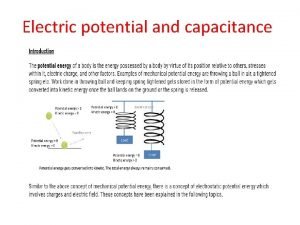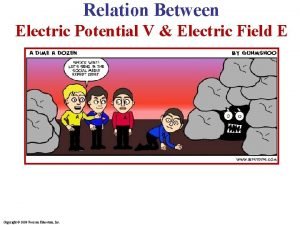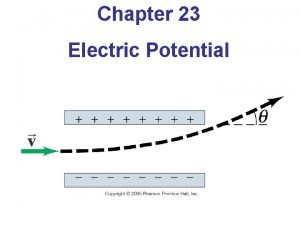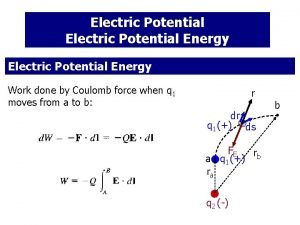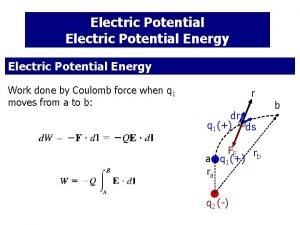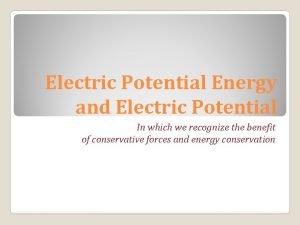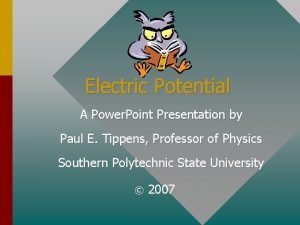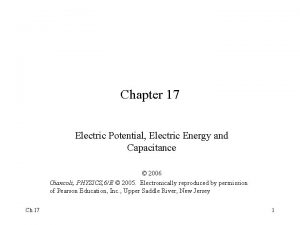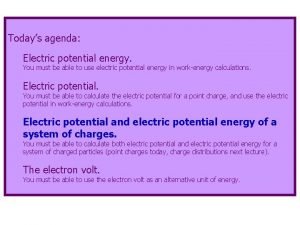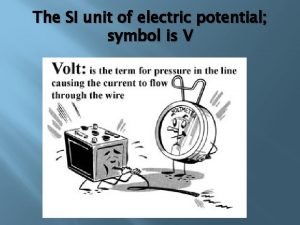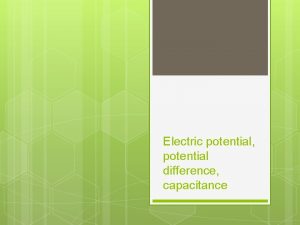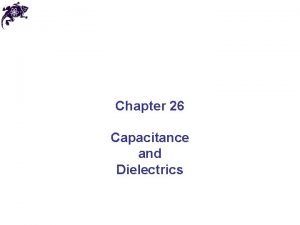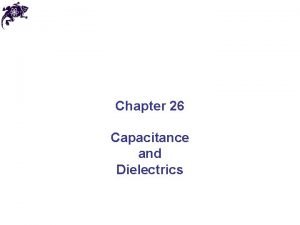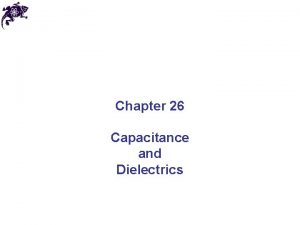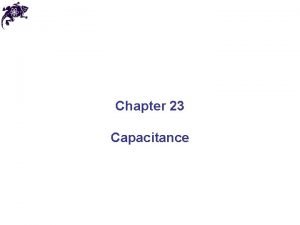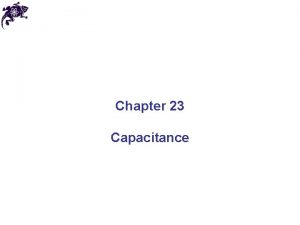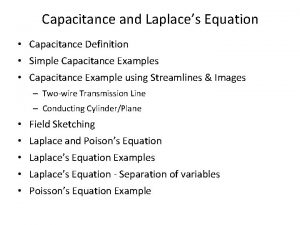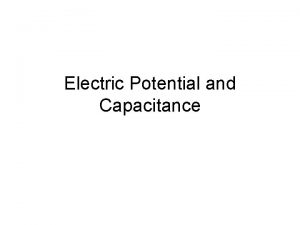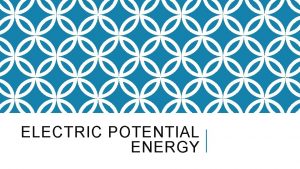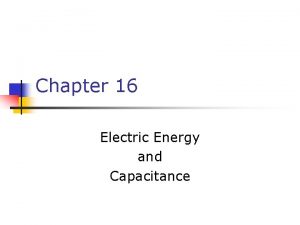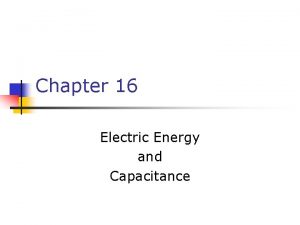Chapter 17 Electric Potential Electric Energy and Capacitance




















- Slides: 20

Chapter 17 Electric Potential, Electric Energy and Capacitance © 2002, B. J. Lieb Giancoli, PHYSICS, 5/E © 1998. Electronically reproduced by permission of Pearson Education, Inc. , Upper Saddle River, New Jersey Ch 17 1

Review of Work and Energy Electric potential is based on the concept of work and energy. • Work = (force) (distance) (cos ) • Units are J (joules) 1 J = N m • Potential Energy is energy of position such as the energy stored in a stretched spring or a roller coaster at the top of the first hill • You have to do work to move a positive charge in an electric field to point a, so that charge has electrical potential energy (Pea) • If you release the charge it will “fall” away from the other charge thus gaining kinetic energy KE = ½ m v 2 Ch 17 2

Electric Potential • Electric potential Va is potential energy per unit charge • Often “potential” is used instead of electric potential Unit is a volt (V) which is a joule/coulomb 1 V=1 J/C • • Point b has a higher electric potential than a and thus a positive particle at a has more potential energy than at b. Ch 17 + + + b + + + + + _ _ + _ a _ _ _ _ _ 3

Potential Difference • The difference in potential energy between two points a and b is the work done in moving a charge from one point to the other Wba ( assuming the charge is moved slowly so there in no KE. The same is true for electric potential. • Ch 17 4

Potential Energy Difference • Since electric potential is potential energy per unit charge, we can find the change in potential energy Example: The two parallel plates shown are connected to a 9 V battery. If the charge is +4 C, then the potential PE = (9 V) (4 C)= 36 J If the charge were released at point b it would “fall” to a and gain 36 J of kinetic energy if there was no friction. • Ch 17 + + + b + + + + + _ _ + _ a _ _ _ _ _ 5

Electric Potential and Electric Field • • • Consider the uniform electric field between parallel plates Ignoring signs the work done by the field to move the charge from b to a is W= q Vba Since the E field is uniform, we can also calculate W from W=Fd=q. Ed We can combine these two equations to give Vba = E d This equation is usually written Ch 17 + + + b + + + + + _ _ + _ a _ _ _ _ _ 6

Example 1 Ch 17 7

Equipotential Lines • • • A 9 volt battery is connected to the parallel plates Thus the positive plate is at a potential of 9 V and the negative plate is a 0 V. The green lines are called equipotential lines because every point on the line is at the same electrical potential Notice how the voltage drops as you go from the 9 V plate, which is also an equipotential to the negative plate at 0 V The green lines are actually surfaces in 3 D The equipotentials are always perpendicular to the electric field lines. 9 volts 7. 75 V Ch 17 _ _ _ _ + + + + 4. 5 V 2. 25 V 8

Equipotential Lines of Two Point Charges Ch 17 9

The Capacitor • • What would happen to the charged parallel plates if the battery were disconnected? Answer: Nothing: the + and – charges are attracted to each other, so they would remain. Notice that this is a charge storage device. It also stores energy. The potential difference or voltage V will remain constant This device is called a capacitor and it is often used in electrical circuits. Often the plates are made of a thin foil with a thin insulator between the plates. This can then be rolled up to form a very compact device Ch 17 9 volts + + + + _ _ _ _ 10

The Electron Volt • Many devices accelerate electrons and protons through a given potential difference • Because all charges are e or multiples of e, a special unit of energy has been created called the electron volt Definition: An electron volt (e. V) is the energy gained or lost when a particle of charge e moves through a potential difference of 1 V. 1 e. V = q V = (1. 60 x 10 -19 C)( 1. 0 V) = 1. 60 x 10 -19 J Example: An electron in a TV tube is accelerated through a potential difference of 25, 000 V. What is the kinetic energy of the electron? Answer: KE = 25, 000 e. V KE = (25, 000 e. V) (1. 6 x 10 -19 J/e. V) = 4. 0 x 10 -15 J • • • Ch 17 11

Electric Potential due to Point Charges • To derive an expression for the electric potential of a point charge +Q, we calculate the work done per charge to move a test charge from infinity to a point that is a distance r from Q. This derivation requires calculus because the electric repulsion increases as the test charge moves closer. The result of this derivation is: • • Ch 17 12

Example 2 Ch 17 13

Capacitor Equations I We will now derive several equations that describe the capacitor. • The unit of capacitance is the farad (F). • Q is the charge on one plate (and there is an equal but opposite charge on the other plate) and V is the voltage. • 1 F=1 C/V • We refer to C as the capacitance. • Most capacitors are F or smaller Ch 17 + + + + _ _ _ _ 14

Capacitor Equations II Another not-derived equation allows us to calculate the capacitance of a particular parallel plate. C = 0 (A/d) Where A is the area of the plates, d is the distance between them and 0 is called the permittivity of free space. 0 = 8. 85 x 10 – 12 C 2/Nm 2 The symbol of the capacitor used in circuit drawings is: Ch 17 + + + + _ _ _ _ 15

Dielectrics Most capacitors have an dielectic material between the plates that • Increases capacitance • Allows higher voltages • Maintains distance d • The formula for a capacitor with a dielectric is (this is the formula to remember). C = K 0 ( A / d ) where K is called the dielectric constant. Dielectric Constants (20 degrees C) Ch 17 Vacuum 1. 0000 Air 1. 0006 Vinyl (plastic) 2. 8 -4. 5 Mica 7 Water 80 16

How Dielectrics Work • The molecules in dielectrics become polar which means that the electrons tend to be located closer to the positive plate as shown below. • A test charge inside the dielectric feels a E field reduced by 1 / K and thus a smaller V. + + + + Ch 17 -+ -+ -+ -+ -+ -+ _ _ _ _ 17

Energy Storage in a Capacitor A battery must do work to move electrons from one plate to the other. The work done to move a small charge q across a voltage V is W = V q. As the charge increases, V increases so the work to bring q increases. Using calculus we find that the energy (U) stored on a capacitor is given by: Ch 17 18

Example 3 Ch 17 19

Cathode Ray Tube (CRT) • Electrons are ejected from heated metal called cathode • Then accelerated through potential difference of as much as 25, 000 V • Electron beam is then bent by horizontal and vertical electric fields created by the horizontal and vertical deflection plates. • Electron beam then strikes fluorescent screen • Points on screen fluoresce in different colors • Electronics attached to deflection plates cause beam to paint a picture on screen • Picture made with 525 horizontal lines • Picture redrawn at 30 Hz Ch 17 20
 Electric potential energy
Electric potential energy Electric potential energy
Electric potential energy Expression for electric potential difference
Expression for electric potential difference Define electric potential and potential difference.
Define electric potential and potential difference. Electric potential
Electric potential Electric potential of dipole
Electric potential of dipole Equipotential surface
Equipotential surface Formula for electric field
Formula for electric field Electric potential and electric field
Electric potential and electric field What is the relation between e and v
What is the relation between e and v Relation between potential energy and electric field
Relation between potential energy and electric field Work done by coulomb force
Work done by coulomb force Work done by coulomb force
Work done by coulomb force Direction of electric potential
Direction of electric potential O que é ddp
O que é ddp Electric potential energy of capacitor
Electric potential energy of capacitor Energy formula
Energy formula Electrostatic potential energy of a system of charges
Electrostatic potential energy of a system of charges Electric potential symbol and unit
Electric potential symbol and unit Electric potential energy
Electric potential energy Electric potential energy
Electric potential energy






